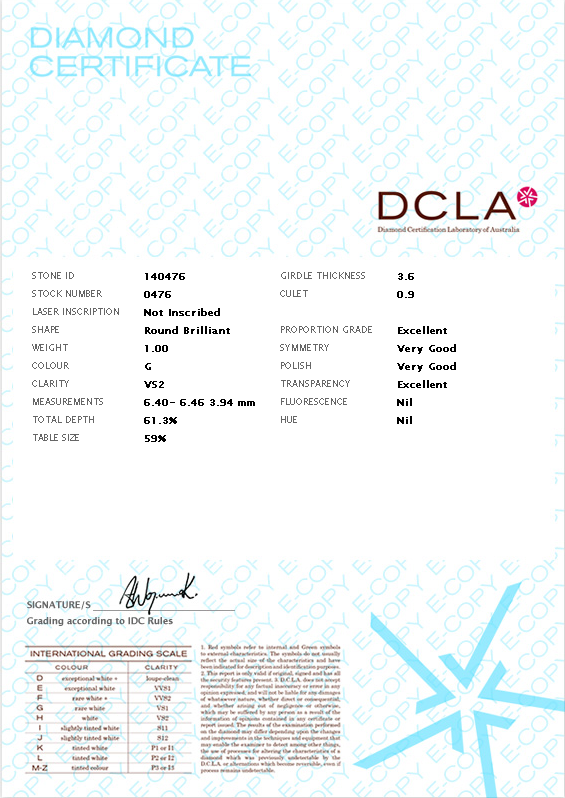Grading Report: The Blueprint of a Diamond’s Quality
A grading report, also known as a diamond certificate, is an official document issued by a recognised and independent diamond grading laboratory. It provides a detailed, unbiased assessment of a diamond’s characteristics based on internationally accepted grading standards.
This report plays a critical role in determining a diamond’s quality, authenticity, and market value, allowing buyers, sellers, and investors to make informed decisions.
What is Included in a Diamond Grading Report?
A diamond grading report contains a comprehensive analysis of a diamond’s physical and optical properties. The following elements are typically included:
1. Identification Details
Report Number – A unique serial number assigned to the diamond, used for tracking and verification.
Date of Examination – The date the diamond was graded.
Laboratory Name & Logo – Ensures authenticity and trustworthiness of the certification body (e.g., DCLA, GIA, IGI, HRD).
2. The 4Cs of Diamond Grading
Carat Weight – The diamond’s exact weight, measured to the nearest hundredth of a carat.
Cut Grade – Evaluates the diamond’s proportions, symmetry, and polish, impacting its brilliance and fire.
Colour Grade – Determines how colourless the diamond is, graded on a scale from D (colourless) to Z (light yellow/brown).
Clarity Grade – Assesses internal inclusions and surface blemishes, ranging from Flawless (FL) to Included (I3).
3. Additional Diamond Characteristics
Shape & Cutting Style – Specifies the diamond’s shape (e.g., round, princess, oval) and cut style.
Measurements – Precise dimensions of the diamond, including diameter, table size, and depth.
Girdle Thickness – Evaluates the diamond’s girdle proportion (thin, medium, thick).
Culet Size – Determines if the bottom facet (culet) is pointed, small, or large.
Polish & Symmetry – Rates how well the diamond’s facets are cut and aligned, affecting its sparkle.
Fluorescence – Indicates if the diamond emits a glow under UV light, rated from None to Strong.
4. Diamond Proportions & Light Performance
Proportion Diagram – A detailed illustration showing the diamond’s exact cut proportions.
Light Performance Analysis (in some reports) – Shows how effectively the diamond reflects light.
5. Clarity Characteristics Plot (Inclusion Map)
A diagram indicating the type, location, and size of inclusions or blemishes.
Helps identify the diamond and distinguish it from others.
6. Comments & Additional Features
Any unique observations about the diamond, such as laser inscriptions or special cutting techniques.
7. Security Features & Verification
Some reports contain laser-engraved serial numbers on the girdle for easy identification.
Advanced security features like holograms, QR codes, and online verification portals ensure authenticity.
Grading Report vs. Appraisal: What’s the Difference?
Many people mistakenly believe a grading report and an appraisal are the same, but they serve different purposes:
Feature Grading Report Appraisal
Issued By Independent gemological laboratory (e.g., GIA, DCLA, IGI) Jewellery appraiser or valuation expert
Purpose Determines the diamond’s quality Assigns a monetary value for insurance, resale, or probate
Contains a Value? No monetary value Includes an estimated market value
Objectivity Completely unbiased May be influenced by market trends or jeweller pricing
Validity Period Permanent Needs updating over time due to price fluctuations
A diamond grading report is not an appraisal—it does not assign a price to the diamond but provides an objective assessment of its quality and characteristics.
Why is a Grading Report Important?
Ensures Trust & Transparency
Provides a scientific, unbiased evaluation of the diamond’s quality.
Helps prevent fraud or misrepresentation by verifying the diamond’s true attributes.
Helps Determine Market Value
A certified diamond holds more value than an uncertified one.
Allows buyers to compare diamonds based on verified grading standards.
Essential for Insurance & Resale
Insurance companies require a grading report to determine coverage and replacement value.
A report helps sellers accurately price and market their diamond.
Prevents Overpaying
Ensures buyers are not paying for a diamond that does not match its advertised quality.
Helps investors and collectors make informed purchases.
Which Laboratories Issue Grading Reports?
Only independent and reputable gemological laboratories should issue a grading report. Some of the most respected names in the industry include:
DCLA (Diamond Certification Laboratory of Australia) – The official CIBJO laboratory for Australia, known for strict and consistent grading.
GIA (Gemological Institute of America) – One of the most widely recognised authorities in diamond grading.
IGI (International Gemological Institute) – Popular for grading both natural and lab-grown diamonds.
HRD (Hoge Raad voor Diamant, Belgium) – Known for high standards in diamond certification.
Always check the laboratory’s reputation before relying on a grading report, as some lesser-known labs may have looser grading standards.
